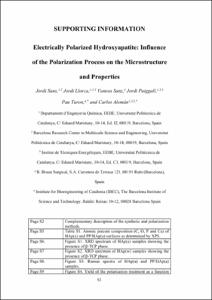Mostra el registre d'ítem simple
Electrically polarized hydroxyapatite: influence of the polarization process on the microstructure and properties
| dc.contributor.author | Sans Milà, Jordi |
| dc.contributor.author | Llorca Piqué, Jordi |
| dc.contributor.author | Sanz, Vanesa |
| dc.contributor.author | Puiggalí Bellalta, Jordi |
| dc.contributor.author | Turón Dols, Pau |
| dc.contributor.author | Alemán Llansó, Carlos |
| dc.contributor.other | Universitat Politècnica de Catalunya. Doctorat en Polímers i Biopolímers |
| dc.contributor.other | Universitat Politècnica de Catalunya. Departament d'Enginyeria Química |
| dc.date.accessioned | 2020-02-12T11:16:36Z |
| dc.date.available | 2020-02-12T11:16:36Z |
| dc.date.issued | 2019-11-19 |
| dc.identifier.citation | Sans, J. [et al.]. Electrically polarized hydroxyapatite: influence of the polarization process on the microstructure and properties. "Langmuir", 19 Novembre 2019, vol. 35, núm. 46, p. 14782-14790. |
| dc.identifier.issn | 0743-7463 |
| dc.identifier.uri | http://hdl.handle.net/2117/177540 |
| dc.description.abstract | Semipermanently polarized hydroxyapatite, named SP/HAp(w), is obtained by applying a constant dc electric field of 1–10 kV/cm at 300–850 °C to the samples previously sintered in water vapor, while permanently polarized hydroxyapatite, PP/HAp(a), is produced by applying a dc electric field of 3 kV/cm at 1000 °C to the samples sintered in air. SP/HAp(w) has been used for biomedical applications, while PP/HAp(a) has been proved to be a valuable catalyst for N2 and CO2 fixation. In this work, structural differences between SP/HAp(w) and PP/HAp(a) have been ascertained using Raman microscopy, wide-angle X-ray diffraction, scanning electronic microscopy, high-resolution transmission electron microscopy, and grazing incidence X-ray diffraction. Results prove the existence of crystal distortion in the form of amorphous calcium phosphate and ß-tricalcium phosphate (ß-TCP) phases close to the surface because of the atmosphere used in the sintering process. The existence of an amorphous layer in the surface and the phase transition through ß-TCP of SP/HAp(w) are the structural factors responsible for the differences with respect to PP/HAp(a). Moreover, a superstructure has been identified in PP/HAp(a) samples, which could be another structural factor associated with enhanced conductivity, permanent polarization, and catalytic activity of this material |
| dc.format.extent | 9 p. |
| dc.language.iso | eng |
| dc.rights | Attribution-NonCommercial-NoDerivs 3.0 Spain |
| dc.rights.uri | http://creativecommons.org/licenses/by-nc-nd/3.0/es/ |
| dc.subject | Àrees temàtiques de la UPC::Enginyeria química |
| dc.subject.lcsh | Polarization (Electricity) |
| dc.subject.lcsh | Hydroxyapatite |
| dc.subject.lcsh | Biomedical materials |
| dc.subject.other | Crystals |
| dc.subject.other | Lattices |
| dc.subject.other | Defects in solids |
| dc.subject.other | Polarization |
| dc.title | Electrically polarized hydroxyapatite: influence of the polarization process on the microstructure and properties |
| dc.type | Article |
| dc.subject.lemac | Polarització (Electricitat) |
| dc.subject.lemac | Hidroxiapatita |
| dc.subject.lemac | Materials biomèdics |
| dc.contributor.group | Universitat Politècnica de Catalunya. NEMEN - Nanoenginyeria de materials aplicats a l'energia |
| dc.contributor.group | Universitat Politècnica de Catalunya. PSEP - Polimers Sintètics: Estructura i Propietats. Polimers Biodegradables |
| dc.contributor.group | Universitat Politècnica de Catalunya. IMEM-BRT- Innovation in Materials and Molecular Engineering - Biomaterials for Regenerative Therapies |
| dc.identifier.doi | 10.1021/acs.langmuir.9b02522 |
| dc.description.peerreviewed | Peer Reviewed |
| dc.relation.publisherversion | https://pubs.acs.org/doi/abs/10.1021/acs.langmuir.9b02522 |
| dc.rights.access | Open Access |
| local.identifier.drac | 26417314 |
| dc.description.version | Postprint (author's final draft) |
| local.citation.author | Sans, J.; Llorca, J.; Sanz, V.; Puiggali, J.; Turón, P.; Aleman, C. |
| local.citation.publicationName | Langmuir |
| local.citation.volume | 35 |
| local.citation.number | 46 |
| local.citation.startingPage | 14782 |
| local.citation.endingPage | 14790 |
Fitxers d'aquest items
Aquest ítem apareix a les col·leccions següents
-
Articles de revista [398]
-
Articles de revista [244]
-
Articles de revista [152]
-
Articles de revista [181]
-
Articles de revista [2.223]


